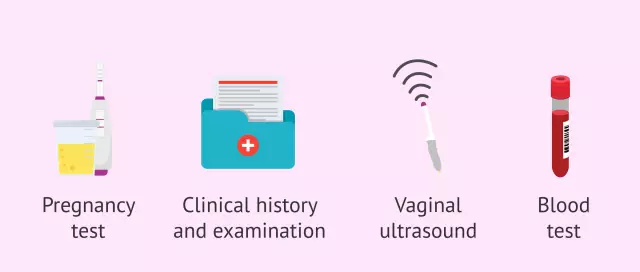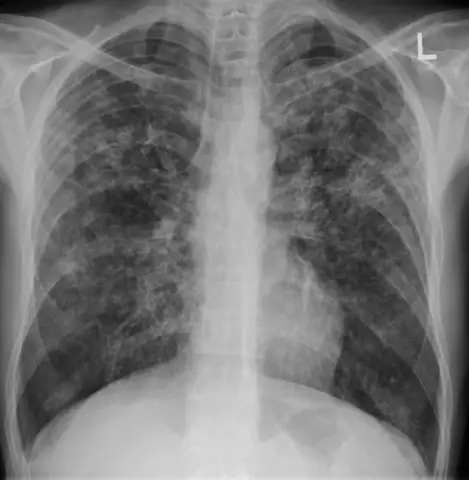- Author Rachel Wainwright [email protected].
- Public 2023-12-15 07:39.
- Last modified 2025-11-02 20:14.
Amenorrhea
Amenorrhea, translated from Latin, means the absence of monthly bleeding, that is, menstruation. Amenorrhea is not an independent disease, it is a syndrome characteristic of many diseases, not only of the female genital area, but also of some common ones. In addition, amenorrhea is physiological, that is, normal for a given period of a woman's life. This is age-related amenorrhea (in prepubertal girls and women who have reached menopause), amenorrhea during pregnancy and lactational amenorrhea.
Causes of amenorrhea

The onset of menstruation is regulated by a neurohumoral mechanism, which is provided by the brain, nervous system and hormones. Failure at any stage of this mechanism can cause amenorrhea. Also, the causes of amenorrhea can be physiological processes in a woman's body that are not abnormalities. Another group of causes of amenorrhea are abnormalities in the anatomical structure, which can be congenital or acquired.
All causes of amenorrhea are divided into primary and secondary.
Primary amenorrhea is a condition where menstruation does not appear at all. Secondary amenorrhea is a condition when the existing menstruation has stopped for one reason or another.
Primary amenorrhea can be caused by the following:
- Anatomical causes of amenorrhea. A delay in the development of the reproductive system, as well as anomalies in the structure of the external genital organs (this includes false amenorrhea, when spotting is formed, but does not come out due to contamination in the hymen or vagina);
- Hereditary or genetic causes of amenorrhea. This group includes abnormalities in the structure of internal genital organs as a result of hereditary diseases (Turner syndrome, Kallmann syndrome, testicular feminization syndrome, etc.) or other disorders that occurred during intrauterine development;
- Physiological causes of amenorrhea. Physiologic primary amenorrhea is normal before puberty.
Secondary amenorrhea can be caused by the following factors:
- Omotional and mental causes of amenorrhea;
- Physical overload. Hard physical work, excessive hobby for sports can cause amenorrhea;
- Pituitary insufficiency, usually caused by a tumor process in the pituitary gland;
- Chronic inflammatory diseases of the uterine appendages (chronic adnexitis);
- Polycystic ovary disease;
- The degeneration of normal ovarian tissue into a cicatricial fibrous structure as a result of adnexitis;
- Tumors of the ovaries and fallopian tubes;
- Endocrine diseases;
- Fat metabolism disorders: obesity or vice versa, a critical decrease in the amount of adipose tissue necessary for the normal metabolism of estrogen;
Diagnosis of amenorrhea

The diagnosis of pathological amenorrhea is made on the basis of the absence of menstruation after the onset of sixteen years of age (primary amenorrhea) or as a result of the cessation of menstruation for more than six months (secondary amenorrhea).
Diagnostic measures are carried out in order to find out the cause of the deviation, and depending on the form (primary amenorrhea or secondary amenorrhea), they have some differences.
In primary amenorrhea, karyotyping is mandatory - genetic diagnosis, consisting in the study of the chromosome set. A family history is collected in order to identify a possible hereditary predisposition. Ultrasound of the pelvic organs, gynecological examination, determination of the hormonal status in dynamics are also used. Depending on the detected deviations, one or another additional study may be assigned.
Diagnosis of secondary amenorrhea includes gynecological examination, ultrasound, including intravaginal ultrasound, blood and urine tests, bacteriological sowing of vaginal secretions, hormonal diagnostics, examination of the immune system, endoscopic examination of internal genital organs. If a tumor is suspected, CT (computed tomography) or MRI (magnetic resonance imaging) are performed.
Treatment of amenorrhea
Treatment of amenorrhea consists in eliminating the cause that caused its appearance. The general treatment regimen for amenorrhea is as follows:
- With amenorrhea caused by hormonal deficiency, the cause of the deficiency is eliminated, and if this is not possible, the hormonal deficiency is corrected using hormone replacement therapy;
- Treatment of amenorrhea caused by inflammatory gynecological diseases consists in the use of anti-inflammatory therapy, sometimes there is a need for surgical intervention (elimination of adhesions, restoration of patency of the fallopian tubes, etc.);
- Treatment of amenorrhea caused by psycho-emotional problems consists in correcting the neurological status: mild sedatives are prescribed, relaxation techniques are taught, a prerequisite is the normalization of rest and activity, sometimes a job change is required;
In addition, the most important condition for the successful treatment of amenorrhea in any of its forms is the normalization of the lifestyle in general. It is necessary to maintain a healthy lifestyle, with sufficient, but not excessive physical activity and proper nutrition.
Treatment of amenorrhea with folk remedies

Treatment of amenorrhea with folk remedies can only be effective if the amenorrhea is caused by inflammatory processes or psycho-emotional reasons. In all other cases, the correction can only be made by qualified medical intervention.
To eliminate the inflammatory causes of amenorrhea, folk remedies are usually medicinal herbs in the form of decoctions and infusions, used either locally in the form of baths and douching, or in the form of teas in order to generally strengthen the body. As anti-inflammatory agents, decoctions and infusions of calamus, eucalyptus, string, celandine, St. John's wort, mother-and-stepmother, sage, chamomile and other medicinal herbs are used. As a tonic - aloe juice, St. John's wort, elecampane, fragrant rue. Also, honey and other beekeeping products are used as general strengthening and immunostimulating folk remedies for amenorrhea: pollen, royal jelly.
In the presence of psycho-emotional causes of amenorrhea, folk remedies are used as a mild sedative. These are tinctures or teas from motherwort, yarrow, valerian, peppermint, lemon balm, valerian, hops.
Before treating amenorrhea with folk remedies, it is necessary to consult a doctor and undergo a diagnosis, as well as make sure that there is no allergic reaction to the drugs used.
YouTube video related to the article:
The information is generalized and provided for informational purposes only. At the first sign of illness, see your doctor. Self-medication is hazardous to health!






